Our Local Pollinators
Hummingbirds
About Hummingbirds
These magnificent jewels of the sky are found only in the Americas. Hummingbirds are important pollinators for many of our native plants. They are known for their iridescent feathers, small size, and ability to hover while feeding from flowers. They can fly up and down, backwards and sideways. To achieve these acrobatic feats, a hummingbird flaps its wings up to 70 times per second, which requires a great amount of energy. During an average day, a hummingbird visits hundreds of flowers, eating several times its weight in nectar.
They are drawn to brightly- colored tubular-shaped flowers, for which their beaks are perfectly adapted. It’s the hummingbird’s tongue, not its beak, that is used lap up nectar from deep within a flower’s base, like a dog licking up water at high speed. In 1 second it can dip into the nectar 13 times.
For protein, hummingbirds eat insects, often finding them inside a flower or catching them in the air.
Broad-billed hummingbird
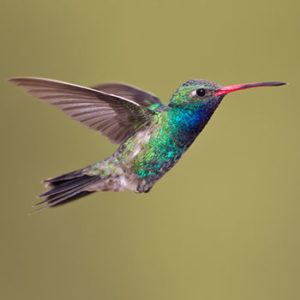
A strikingly colorful bird, the Broad-billed Hummingbird is native to our region. It is a small hummingbird, with a length of 8.2 – 10.2 cm (3.5 to 3.9 inches) and a weight of about 3 grams. Its average wingspan is 12.7 cm (5 inches). It has a bright red beak with a black tip and a blue throat. Adult males have metallic green bodies, vivid blue throats and black forked tails. The adult females have metallic green upper parts and grayish throats and undersides. Their tails have pale outer tips and she has a thin white spot behind her eye.
Local name: Colibrí Pico Ancho.
Violet Crowned Hummingbird
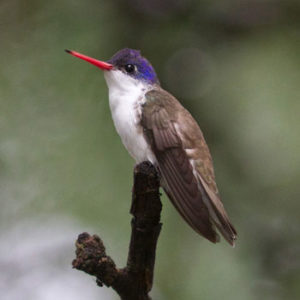 The Violet-crowned Hummingbird is native to our region. It is considered to be a medium-sized, long-bodied hummingbird that has a highly remarkable violet-colored cap, bright white underparts, greenish-brown back and wings, and a red beak with a black tip. It is the only American hummingbird species in which the males lack a brightly colored throat patch. The females are less colorful than the males, but with the same characteristics. It grows to a length of 10 cm (4 inches) long and weighs about 5.19 grams. It is known to be a bit of a bully at nectar feeders.
The Violet-crowned Hummingbird is native to our region. It is considered to be a medium-sized, long-bodied hummingbird that has a highly remarkable violet-colored cap, bright white underparts, greenish-brown back and wings, and a red beak with a black tip. It is the only American hummingbird species in which the males lack a brightly colored throat patch. The females are less colorful than the males, but with the same characteristics. It grows to a length of 10 cm (4 inches) long and weighs about 5.19 grams. It is known to be a bit of a bully at nectar feeders.
Local name: Colibrí Corona Violeta
Black-chinned Hummingbird
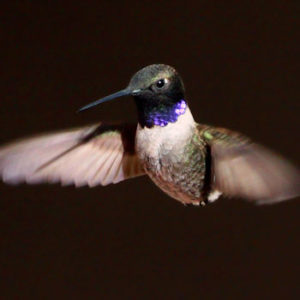 Black-chinned Hummingbirds may be seen year-around in our region, but generally seen in the fall and spring during the migration seasons. In broad daylight, the remarkable thin strip of iridescent purple that borders its black chin becomes highly noticeable. A small green-backed hummingbird of the West, with no brilliant colors on its throat except a thin strip of iridescent purple bordering the black chin, only visible when light hits it just right.
Black-chinned Hummingbirds may be seen year-around in our region, but generally seen in the fall and spring during the migration seasons. In broad daylight, the remarkable thin strip of iridescent purple that borders its black chin becomes highly noticeable. A small green-backed hummingbird of the West, with no brilliant colors on its throat except a thin strip of iridescent purple bordering the black chin, only visible when light hits it just right.
Local name: Colibrí Barba Negra
Ruby throated Hummingbird
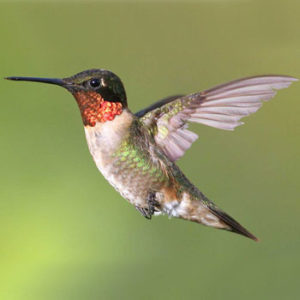 These brilliant, tiny, precision-flying creatures glitter like jewels in the full sun, then vanish with a zip toward the next nectar source. Hovering in front of a flower to sip nectar, it beats its wings more than 50 times per second. Impressive migrants despite their small size, some Ruby-throats may travel from Canada to Costa Rica.
These brilliant, tiny, precision-flying creatures glitter like jewels in the full sun, then vanish with a zip toward the next nectar source. Hovering in front of a flower to sip nectar, it beats its wings more than 50 times per second. Impressive migrants despite their small size, some Ruby-throats may travel from Canada to Costa Rica.
Local name: Colibrí Garganta Rubi
Rivoli's Hummingbird (aka Magnificent)
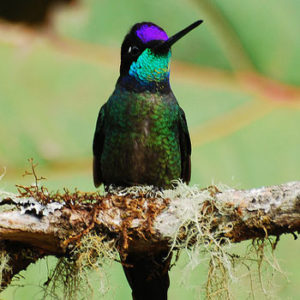
The spectacular Rivoli’s Hummingbird is one of several hummingbird species found in the extreme southwestern U.S. and Mexico. In hovering flight, the wingbeats are almost slow enough for the human eye to see. The species was known as Magnificent Hummingbird from the 1980s until 2017.
Local name: Colibrí Magnífico
Butterflies & Moths
About Butterflies & Moths
Two-tailed Tiger Swallowtail
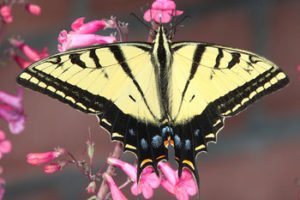
Black Swallowtail
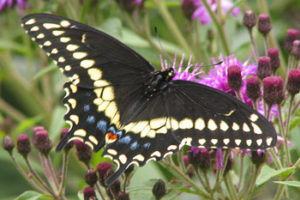
Pink-spotted Swallowtail
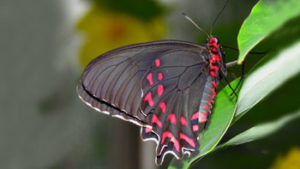
Monarch Butterfly
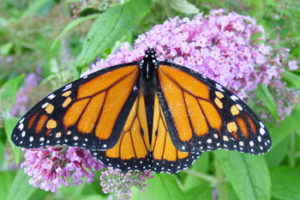
Mexican Silver Spot
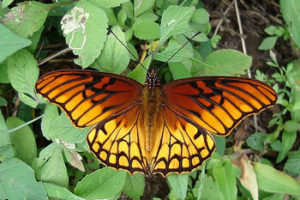
Queen Butterfly
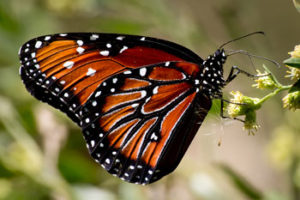
Zebra Longwing
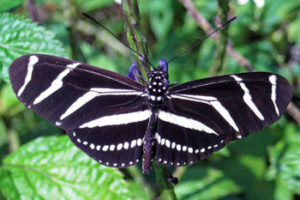
Bees
About Bees
Honey Bees
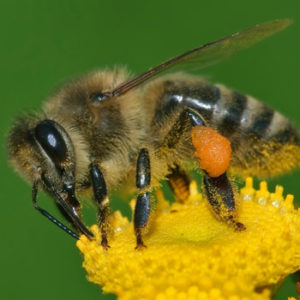
The true honey bees (genus Apis) have, without doubt, the most complex social behavior among bees. The European (or western) bee, Apis mellifera, is the most well-known bee species and one of the best-known insects.
Although they are known for their honey, their greatest value is as a pollinator. Honey bees are generalists, meaning that they visit a wide-range of flowering plants and agricultural crops, moving pollen from flower to flower within the same species.
Bumblebees
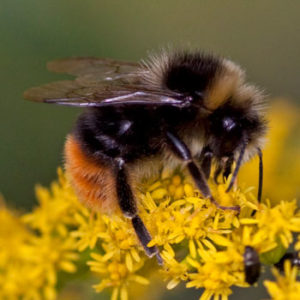
Bumblebees are social insects that form colonies with a single queen and up to 400 worker bees. They are much larger than honey bees, and they are particularly good at pollination of agricultural crops and wildflowers. Bumblebees have round bodies covered in soft hair (long branched setae) called pile, making them appear and feel fuzzy. Their size of 3/4 of inch and larger, combined with their rapid wing beat of 130 times or more per second vibrates pollen from even the most resistant flowers. In agriculture, bumblebees are particularly important for pollinating tomatoes, potatoes, alfalfa, blueberries and squash.
Many bumblebee species nest underground, choosing old rodent burrows or sheltered places, and avoiding places that receive direct sunlight that could result in overheating. Other species make nests above ground, whether in thick grass or in holes in trees.
Of the 250 species of bumblebee world-wide, only 19 live in Mexico, and like honey bees and many other bees their populations are declining world-wide due to pesticide use and climate change.
Female bumblebees can sting repeatedly, but generally ignore humans and other animals.
Solitary Bees
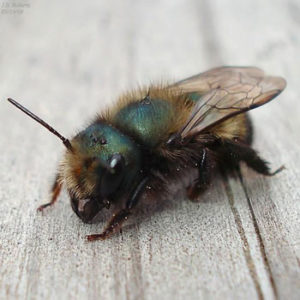 Photo: Garden Mason Bee, Osmia lignaria.
Photo: Garden Mason Bee, Osmia lignaria.
There are over 2,000 solitary bees in Mexico including mason bees, horn-faced bees, carpenter bees, sweat bees, polyester bees, dwarf carpenter bees, leaf cutters and excavator (digger) bees.
Solitary bees are important pollinators. They consume nectar and gather pollen for nesting and feeding for their young, and in the process help to fertilize plants as they carry pollen from flower to flower. They usually only collect pollen from one or a few species of plants, unlike honey bees and bumblebees which are generalists, thus, they are quite essential to their plant partners and vice versa.
Solitary bees do not form hives like honey or bumble bees. They do not produce honey or beeswax, so there is no need for a colony of bees to conduct this work.
Usually the female builds and occupies a nest on her own, within wood cavities (tree trunks and branches or wood houses/buildings) or, more commonly, in tunnels underground. They may be perceived to be social bees, since some Solitary bee species prefer to make their nests near one another and others may share a common nest.
Solitary bees are not aggressive, rarely stinging and never swarming.
Sources: Abejapedia and Grow Wild UK
To find out more about other pollinators, check out this article.
Subscribe to our newsletter
Our monthly newsletter will keep you up to date on our scheduled events, our work, and features monthly nature-related articles.
